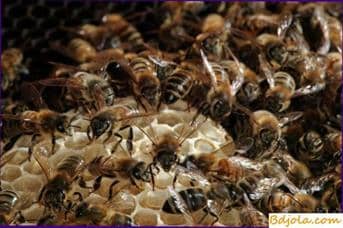
Nectar, in addition to sugar, contains mineral salts, acids, vitamins, enzymes, nitrogenous, dextrin-like, aromatic and other substances, as well as yeast (spores of fungi) that enter it from the air. Nectar, collected by bees from most plants, is very liquid.
In a hive, it would quickly be fermented, but bees never allow spoiling of nectar, which they folded into honeycomb cells. This is achieved primarily by rapid condensation of nectar to a level at which yeast can not develop.
In one experiment, the same strength bee families were given sugar syrup of different concentrations – 50, 60 and 70%. A day later in all families the concentration of syrup reached 71-72%, regardless of the initial concentration.
With abundant honey, as noted earlier, bees only contribute so much nectar (syrup) that they are able to process. Regulate the nectar of the bee-receiver. They place freshly introduced nectar in empty cells or in honeycombs located respectively near and near the brood, ie, in the warmest places of the nest. Cells of a bee fill no more than on 1/3, suspending droplets of a nectar to the top walls and a bottom of cells that promotes the most intensive evaporation of water from a nectar.
During abundant honey harvest, bees reduce the relative humidity in the places where nectar is folded. Thus, with intensive honey gathering, the relative humidity of air in these places was 54-66%, whereas in normal conditions (up to honey-picking) it fluctuated within 76-91%. Such a decrease in relative humidity, achieved by increased ventilation, significantly increases the moisture capacity of the air and accelerates the evaporation of excess water from nectar. The number of bee-ventilators increases in the hives of hives, which is especially noticeable at night.
In a day, as the nectar thickens, the bees carry it to the cells of the honeycombs farther from the brood, mainly in the upper part of the nest. Here the thickening of the food flows more slowly, the bees fill the cells more fully and eventually fill up to the top.
At one time it was believed that excess water is removed from the nectar while it is in honey beet, when the bee is flying from the flowers to the hive. Such conclusions were made on the basis of observations of falling droplets of a light liquid resembling water on the line of mass summer of bees. However, it has been established by experience that the concentration of the syrup taken in the field and brought to the hive is quite the same. Droplets of the same liquid that is released during the flight of bees with nectar – this is a very watery excrement, formed in large quantities when feeding flying bees with liquid nectar. Nectar is concentrated only in the nest of bees under the influence of purely physical factors: the bees place it so that it has the largest surface for the fastest evaporation of water. In one experiment, 50% sugar syrup was fed to the bees, which they folded into honeycombs, and then some of the cells on this honeycomb were covered with a wire mesh that isolated these cells from the access of the bees. It turned out that the speed of condensation of the syrup isolated from the bees is no different from the rate of its condensation in the cells to which the bees had access.
Рис с медом. Вычинка.
Feeding base of beekeeping